Hands on with the ASUS Fonepad, and ASUS PadFone Infinity
by Brian Klug on February 25, 2013 7:08 PM EST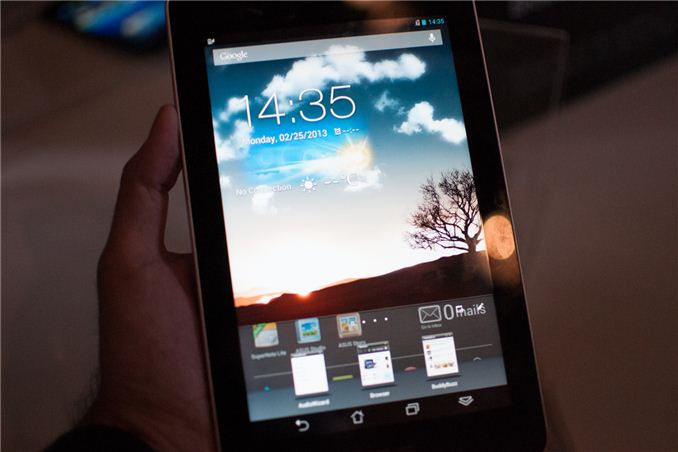
In its annual tradition at MWC, ASUS held a press conference off-site to introduce some of its mobile devices. The introductions are always interesting and typically unique in the marketplace. This year was no different.
To kick things off, ASUS introduced the Fonepad: a 7-inch Android 4.1.2 tablet that also serves as a phone. Samsung launched the Galaxy Note 8.0 earlier this week with a similar capability. While I don't expect many folks to want to hold a 7-inch tablet up to their face, having the ability to combine both tablet and smartphone functionality into one can be tempting. I can see the Fonepad being compelling if you don't make calls all that often but would rather carry a small tablet than a large smartphone, or if you are fine using a Bluetooth headset.
The device is pretty much a Nexus 7 but with a nice metal back. The dimensions are near identical to the Nexus 7 at 196.4mm x 120.1mm x 10.4mm with a weight of 340 grams. The display resolution remains 1280 x 800 and the IPS panel is LED backlit.
In a curious change of pace, ASUS integrated Intel's Atom Z2420 SoC (single-core + HT, 1.2GHz 32nm, PowerVR SGX 540). I'm curious to see how the single core, low-clocked Atom SoC does compared to Tegra 3 in a tablet. Driving all phone functionality is Intel's XMM 6265 baseband, with support for 850/900/1900/2100MHz WCDMA and 850/900/1800/1900MHz EDGE/GSM bands. There's support for 802.11b/g/n and BT 3.0.
The Fonepad features 1GB of LPDDR2 memory and 16GB of NAND on-board, with a microSD slot for additional storage expansion (a notable absence from the Nexus 7). There's an integrated 16Wh battery (like in the N7) and the device will be available in titanium gray and champagne gold (like the Transformer Prime).
The big selling point of the Fonepad is its price: $249. That's a pretty impressive deal for a full featured smartphone and 7-inch tablet in one. It's a bit of a quirky product, but I can definitely see the Fonepad filling a niche.
Next up is the ASUS PadFone Infinity. For those of you who aren't familiar with the PadFone concept, it's pretty simple. Take a phone that can dock into and power a tablet display and you have PadFone. The tablet part is strictly a display + battery, all compute and connectivity is driven by the phone element.
The PadFone Infinity takes a 5-inch 1080p Snapdragon 600 based smartphone running Android 4.2 and pairs it with a 10.1-inch 1920 x 1200 tablet dock (the PadFone Infinity Station). The phone weighs 141g and features an integrated 2400mAh battery, while the tablet dock weighs 530g and comes with a 5000mAh battery.
The phone integrates 2GB of LPDDR2-1066, and will come in both 32GB and 64GB versions. ASUS claims support for 802.11b/g/n and 802.11ac with WiFi Direct, BT 4.0 and NFC. Thanks to Qualcomm's baseband, there's full DC-HSPA+ and UE category 3 LTE support.
The PadFone features a 13MP rear facing camera with f/2.0 aperture lens and a 2MP front facing camera. When in tablet mode, the rear camera remains unimpeded while the front camera is replaced with a 1MP module.
Video out is supported via a Mobility DisplayPort interface (MyDP) that runs over the standard micro-USB port on the PadFone.


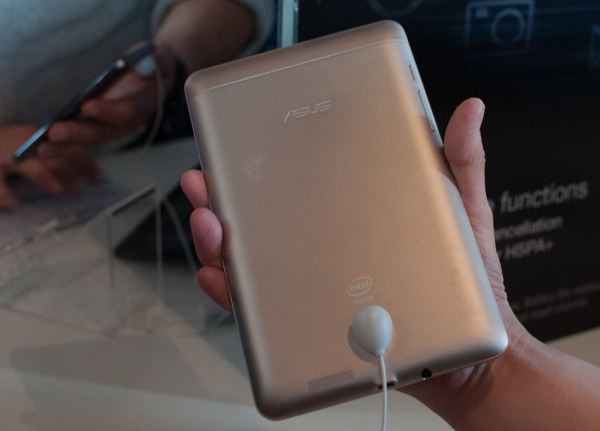

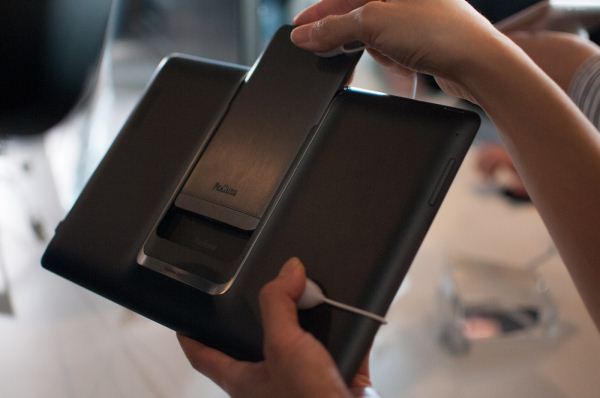
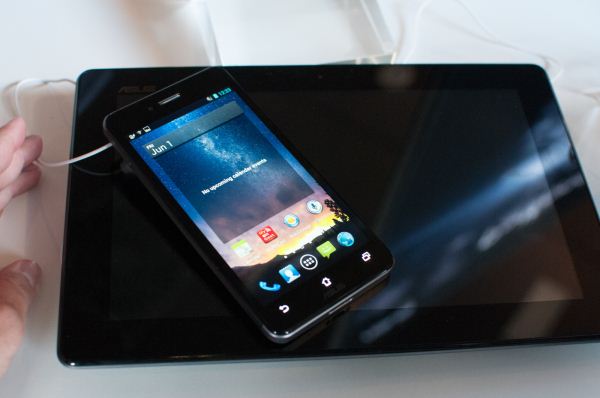
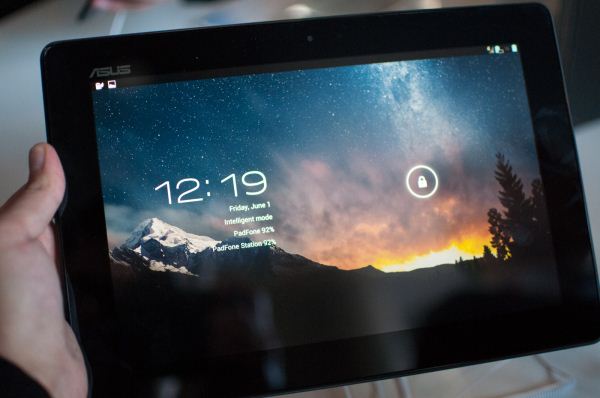














69 Comments
View All Comments
Romberry - Tuesday, February 26, 2013 - link
Seriously, in a day when people use their smart phones mostly for everything other than phone calls (texting, web surfing), a Fonepad makes great sense. Why carry a phone and a tablet? I'd love to have on of these. When it becomes available, if the performance with the silicon they chose is acceptable, I probably will. Great concept.liffey - Tuesday, February 26, 2013 - link
The P1000 Galaxy Tab was released WAY back in 2010 and was very popular. Yes, people do use it for phone callsWilco1 - Tuesday, February 26, 2013 - link
It's hard to understand that one. That's seriously underpowered in 2012, and so far behind in 2013 that's not even funny.... An 1.2GHz Atom is equivalent to one A7 core in the Exynos octa core, or half of a 2.3GHz Tegra 4i core.smartypnt4 - Tuesday, February 26, 2013 - link
I have no idea what you're basing that on... As far as CPU cores go, a single Medfield core with hyper-threading like you see in the fonepad, the RAZR i, and a few other international phones is very competitive with the quad-core A9's in the Exynos 4 and Tegra 3, as competitive with 2 Krait cores in the Snapdragon MSM 8960. Half of a 2.3GHz A9r4 core... That single atom is at least competitive with that, if not beats it outright.Now, yes, that is a bit under-powered still for a new device, but it's not nearly as bad as you make it out to be. It'll be interesting to see exactly where this lands given its cock speed. Most people who have had hands-on time with the tablet indicate that it feels smooth and perfectly usable.
References: See any chart with a single core Atom in it (every Atom in a phone is a single core so far).
smartypnt4 - Tuesday, February 26, 2013 - link
Oh, sorry: For your A7 comparison: an A7 is supposed to deliver A9 performance at lower power, so yeah. There's no way a single Atom is slower than an A7. If you had said A15, you might've had some sort of argument, but even then, I doubt that the A15 is outright faster in every respect.Wilco1 - Tuesday, February 26, 2013 - link
What makes you think that Atom is faster than an A7? Both are 2-way in-order CPUs, which means they are in the same class and will have similar performance.As for A15 vs Atom, check out how the A15 at A1.7GHz beats Atom at 1.66GHz on every single benchmark:
http://www.anandtech.com/show/6422/samsung-chromeb...
So yes, A15 is outright faster in every respect. At 1.9GHz it'll be close to 3 times as fast compared to a 1.2GHz Atom...
smartypnt4 - Wednesday, February 27, 2013 - link
See my comment below; you're right in regards to single core computational performance.That Atom in that benchmark is a 2.5 year old CPU, so of course it's perfectly natural to compare it to a top-of-the-line current gen SoC. /s
I admit, yes, the Exynos 5250 beats the crap out of that Atom. I'm more interested in the newer revisions of Atom like the Saltwell cores in the Mefield and Clover Trail (+) platforms. I don't doubt that the Exynos 5250 beats Medfield, but Clover Trail should give it a run for its money. Note the use of the word *should* there. We shall see.
Wilco1 - Thursday, February 28, 2013 - link
Remember all Atoms are effectively 5 years old as they all use the exact same micro architecture... But for the sake of the argument, let's look at the top of the range Clovertrail Z2760 at 1.8GHz and compare with the same Exynos 5250 at 1.7GHz (both dual cores):http://browser.primatelabs.com/geekbench2/compare/...
With 4 threads it can almost keep up on integer, but loses badly on floating point and memory performance. So there is no chance that CloverTrail(+) can keep up with quad A15 at 2GHz...
smartypnt4 - Thursday, February 28, 2013 - link
I'm wary of comparing cross-platform benchmarks like that. I don't doubt the Exynos 5250 is faster for a host of different reasons not least of which is the dual-channel DDR3-1600 memory hooked up the only versions of the SoC we've seen so far.My point is this: Intel has been doing this a long time. However, their mobile execution thus far has been distinctly un-Intel. If Valleyview contains some of the same architectural enhancements that the Core i-series did, then I think Valleyview could end up being quite competitive. We'll have to wait and see though.
Also, if the A15 cores have an inferior prefetcher or scheduler to Clover Trail, would that show up in the Geekbanch results for FP and integer performance? Or would it only affect the Stream performance?
Wilco1 - Thursday, February 28, 2013 - link
I don't see your issue with cross platform benchmarking, how can you compare systems otherwise?Prefetching issues should show up in stream and other memory intensive apps which do not fit in L2, so unlikely for integer/FP benchmarks. NVidia claims a 15% speedup on average for Tegra 4i, but that includes a better branch predictor and larger TLBs. No idea how much it will help JavaScript.
Could Valleyview be competitive with A15 in performance? Yes that is possible. However Intel won't have an alternative to big.LITTLE or Tegra's 5th core, and fast OoO cores use more power (Bobcat vs Atom). So we'll see how well it does on a 22nm process.